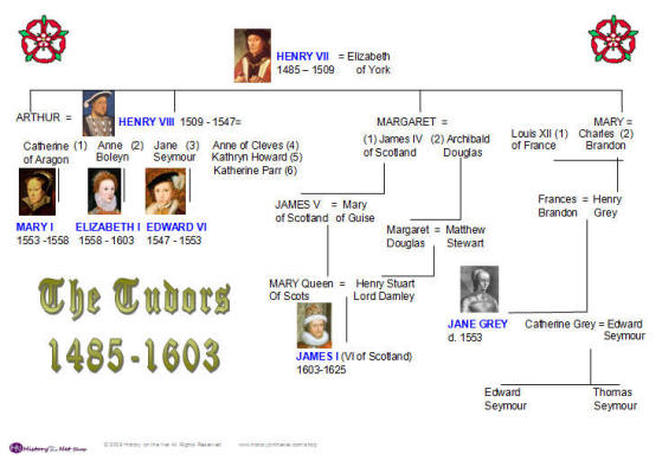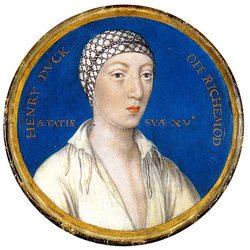Henry VIII and Tudor Times
A Tudor Family Tree
Shown above is the famous portrait showing Henry VIII's line. Although this painting was painted while Henry VIII was married to his sixth queen, Katherine Parr, she does not appear in the portrait. Instead, Henry VIII is shown with his late wife Jane Seymour, the only wife to bear him a son. Henry said that she was "his one true wife" and thus he requested to be buried with her when he himself died. Edward VI is seated to Henry VIII's left. Symbolically separated from the true, legitimate heir by pillars are the Lady Mary on the left and the Lady Elizabeth on the right. The two daughters had been declared illegitimate since Henry VIII's marriages to both of their mothers had been annulled. Thus they were no longer given the title of "Princess." In the archways stand Queen Elizabeth of York and Henry VII, Henry VIII's parents. Thus here is an almost complete portrait of the Tudor dynasty, and certainly a portrait of the Tudor dynasty as Henry VIII saw it.
The Succession
The Tudor Dynasty spanned the reign of Henry VII, Henry VIII's father, Henry VIII himself, and his heirs. Although Edward VI, his only legitimate son by third queen Jane Seymour, was meant to rule the throne after his father, Edward died at the age of 15, likely due to tuberculosis. Henry specified in his will that if Edward were to die, Mary and her children would succeed him, then Elizabeth and her children, and finally the heirs of his sister, Mary Brandon, a one time Queen of France. Lady Jane Grey was one of those heirs, being Princess Mary's granddaughter. However, as Edward VI lay dying, the Lord Protector (a nobleman who was basically acting as king in all but name since Edward VI was underage at the time) arranged that the Lady Jane Grey be named as heir. He planned to marry his youngest son, Guilford, to Lady Jane so that his son would be king. Lady Jane was opposed to both the marriage and to the usurping of the throne that should have been the Lady Mary's. Unfortunately, she was queen for only nine days, and is sometimes referred to as the nine days' queen. When Mary I asserted her right to become queen and succeeded in doing so, the Lady Jane was eventually beheaded at the age of 17. Mary's future husband, Prince Philip of Spain, demanded her execution and refused to come to England to wed Queen Mary until Lady Jane and her husband were dead. Upon Mary's death, Elizabeth I, who was imprisoned either under house arrest or in the notorious Tower of London for much of her sister's reign, acsended the throne.
Below is the Tudor family tree, showing the dates of the reigns of each Tudor monarch. The Tudor monarch was considered to be the King or Queen of England, Ireland, Scotland, and France, due to ancestral claims. However, Mary I lost Calais, the last English holding in France, to the French during her reign. She famously remarked," When I die, they shall find Calais written on my heart." In 1603, the Stuart king James I took the throne, thus ending the Tudor dynasty.
The Tudor Dynasty spanned the reign of Henry VII, Henry VIII's father, Henry VIII himself, and his heirs. Although Edward VI, his only legitimate son by third queen Jane Seymour, was meant to rule the throne after his father, Edward died at the age of 15, likely due to tuberculosis. Henry specified in his will that if Edward were to die, Mary and her children would succeed him, then Elizabeth and her children, and finally the heirs of his sister, Mary Brandon, a one time Queen of France. Lady Jane Grey was one of those heirs, being Princess Mary's granddaughter. However, as Edward VI lay dying, the Lord Protector (a nobleman who was basically acting as king in all but name since Edward VI was underage at the time) arranged that the Lady Jane Grey be named as heir. He planned to marry his youngest son, Guilford, to Lady Jane so that his son would be king. Lady Jane was opposed to both the marriage and to the usurping of the throne that should have been the Lady Mary's. Unfortunately, she was queen for only nine days, and is sometimes referred to as the nine days' queen. When Mary I asserted her right to become queen and succeeded in doing so, the Lady Jane was eventually beheaded at the age of 17. Mary's future husband, Prince Philip of Spain, demanded her execution and refused to come to England to wed Queen Mary until Lady Jane and her husband were dead. Upon Mary's death, Elizabeth I, who was imprisoned either under house arrest or in the notorious Tower of London for much of her sister's reign, acsended the throne.
Below is the Tudor family tree, showing the dates of the reigns of each Tudor monarch. The Tudor monarch was considered to be the King or Queen of England, Ireland, Scotland, and France, due to ancestral claims. However, Mary I lost Calais, the last English holding in France, to the French during her reign. She famously remarked," When I die, they shall find Calais written on my heart." In 1603, the Stuart king James I took the throne, thus ending the Tudor dynasty.
Illegitimate Children
Aside from his three legitimate children (and several legitimate children who died at birth or were miscarried, Henry VIII had at least one illegitimate child and possibly many more. Pictured above is Henry Fitzroy, Duke of Richmond, Henry VIII's illegitimate son by Elizabeth Blount. Henry Fitzroy was born at a time when Henry VIII had no living son, and when it was feared that he or his queen may be incapable of producing one. Thus the popular phrase "God bless Bessie Blount" was coined. Also notice that Henry Fitzroy bears the standard name, Fitzroy, literally, "son of the King" reserved for illegitimate sons. Aside from Henry Fitzroy, who died at age 17 from the sweating sickness, a feared Tudor disease, Henry may have had two illegitimate children with his second wife's sister, Mary Carey (sister of Anne Boleyn.) Scholars debate this point still today. Interestingly, today's house of Windsor is descended from Mary Carey (and possibly from Henry VIII, if the rumors speak truth.) Many other possible illegitimate children also litter the story of Henry VIII.



